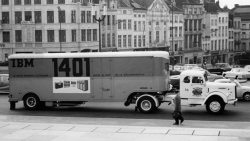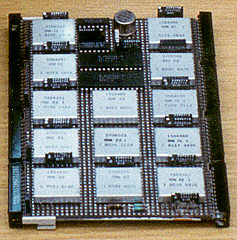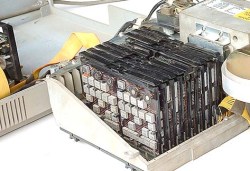
It wasn’t long ago I was nostalgic about an old computer I saw back in the 1980s from HP. It was sort of an early attempt at a PC, although price-wise it was only in reach for professionals. HP wasn’t the only one to try such a thing, and one of the more famous attempts was the company that arguably did get the PC world rolling: IBM. Sure, there were other companies that made PCs before the IBM PC, but that was the computer that cemented the idea of a computer on an office desk or at your home more than any computer before it. Even now, our giant supercomputer desktop machines boot as though they were a vintage 1981 PC for a few minutes on each startup. But the PC wasn’t the first personal machine from IBM and, in fact, the IBM 5100 was not only personal, but it was also portable. Well, portable by 1970s standards that also had very heavy video cameras and luggable computers like the Osborne 1.
The IBM 5100 had a brief three-year life from 1975 to 1978. A blistering 1.9 MHz 16-bit CPU drove a 5-inch CRT monitor and you could have between 16K and 64K of RAM along with a fair amount of ROM. In fact, the ROMs were the key feature and a giant switch on the front let you pick between an APL ROM and a BASIC ROM (assuming you had bought both).
Computer hobbyists in the 1970s loved BASIC, so this was the object of desire for many. The entry price of around $9,000 squashed those dreams, though — that was even more money then than it would be today. The idea was influential, though and there was even a dedicated book published about the machine. Like the HP computer, the main mass storage was via tape drive. You could even get an add-on to make it work as an IBM remote terminal or use the serial port for a modem. If the screen was too small, a BNC connector on the back could drive an external monitor.
Oddities

It may seem funny to think of a 55-pound computer with a CRT as portable. But this was a time when computers sat on raised floors in special rooms with exotic power systems. Prior to this, the military had the most portable computer, also from IBM, which was an IBM 1401 on a special truck.
APL might seem like an odd choice, but in its day it was a prestigious language. Of course, that also meant the machine had to handle the oddball character set and strikeovers necessary for APL in those days. However, APL was very powerful for manipulating large sets of data and if you dropped $10K on a computer, that’s probably what you had in mind. Other workstations — like the one from HP — had you using BASIC which did not have a lot of facilities for dealing with high-level math and matrices, especially in those days.

However, a beta tester for the machine warned IBM that normal people weren’t going to learn APL just to use the machine. This spurred the addition of the BASIC option. However, the way the machine implemented APL and BASIC was perhaps the oddest thing of all.
IBM had no shortage of software to run APL. They also had a BASIC system for the IBM System/3. To save development costs, the 5100’s processor emulated most of the features of a System/360 and a System/3. This way, they could make minor changes to the existing APL and BASIC interpreters. What that means, though, is that the 5100 wasn’t just a portable computer. It was a portable and slow mainframe computer.
Time Travel
Maybe the oddest thing, though, isn’t a technical thing. I don’t remember it being widely known that the IBM5100 was really a tiny mainframe. It probably wouldn’t be attractive for IBM to make that well known, anyway. You don’t want your bread-and-butter mainframe customers either planning to buy a (relatively) cheap replacement or complaining that you are charging them way more than this cheap device that “does the same thing.”
 However, in the year 2000, this became a key plot point in what was almost certainly a time travel hoax. John Titor claimed to be from the year 2036 and that the military had sent him back to 1975 to collect one of these computers. Why? Because after World War III (which supposedly would happen in 2015), they needed the computer to run old IBM software and they couldn’t transport a several-ton mainframe to the future.
However, in the year 2000, this became a key plot point in what was almost certainly a time travel hoax. John Titor claimed to be from the year 2036 and that the military had sent him back to 1975 to collect one of these computers. Why? Because after World War III (which supposedly would happen in 2015), they needed the computer to run old IBM software and they couldn’t transport a several-ton mainframe to the future.
Plausible? Maybe. Even though the predictions didn’t come to pass, true believers will simply say that was because his time travel changed events. We aren’t buying it, but we have to admire that someone knew enough about the IBM 5100 to craft this story.
Try It
I have never seen one of these in person, but I imagine if one came up for sale now, the price would be astronomical. But you can, of course, try the obligatory emulator by [Norbert Kehrer]. Or watch [Abort, Retry, Fail] run a real one in the video, below. There is a lot of detail over on the Computer Museum site if you want to dig into the technology. There were actually a few different models with slightly different options. You’ll find a lot of interesting info over at oldcomputers.net, too, which is where some of the photos in this post are taken from.
If you do dig into the diagrams, it is helpful to know some of the old IBM terminologies. For example, ROS is “read only storage” or what we call ROM. RAM is RWS or read/write storage. Don’t forget, IBM wasn’t keen on ASCII, either.
Maybe I’m biased, but if I had my choice, I’d rather have the old HP machine on my desk. But I will admit that this machine captured my imagination and was a precursor of things to come. Of course, I liked APL, so your take on it might be different. The original IBM PC, by the way, was the model 5150, so the 5100 is sort of its older geeky cousin.

No comments:
Post a Comment